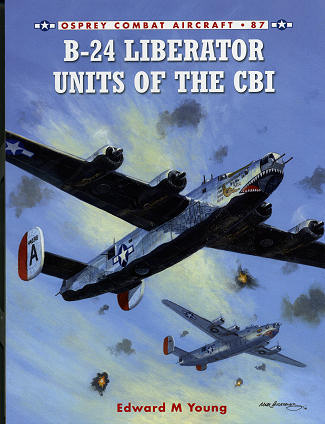 Number
87 in Osprey's Combat Aircraft series is on the B-24 Liberator and operations in
the CBI (China, Burma, India) theater of operations during WWII. Not an area
where one normally thinks of heavy bomber operations as there really were not
all that many major industrial targets, but a place where the 7th and 308th bomb
groups operated during the Pacific War. The 7th was mostly in India and the
308th was mostly in China. Here, these units battled the Japanese, weather, and
in the case of the 308th, a constant lack of fuel, ammunition and supplies.
Number
87 in Osprey's Combat Aircraft series is on the B-24 Liberator and operations in
the CBI (China, Burma, India) theater of operations during WWII. Not an area
where one normally thinks of heavy bomber operations as there really were not
all that many major industrial targets, but a place where the 7th and 308th bomb
groups operated during the Pacific War. The 7th was mostly in India and the
308th was mostly in China. Here, these units battled the Japanese, weather, and
in the case of the 308th, a constant lack of fuel, ammunition and supplies.
The 7th Bomb Group was mainly used in the war in Burma.
This was a theater of on and off operations as the monsoons made war making
nearly impossible due to the poor weather. Yet they harassed the Japanese by
attacking the city of Rangoon and other major centers in southeast Asia. This
included the Japanese rail network and Japanese air fields. It was with the 7th
bomb group that the only aviator in the CBI was to earn the Medal of Honor and
Carswell AFB (for a time the home of the B-52s of the current 7th Bomb Group)
was named after him. When the war wound down, the B-24s were stripped of
armament and used to ferry supplies over the Hump to China.
The 308th was China based and fought as much to have
materials for war making as they did the Japanese. Every gallon of fuel, every
bomb and all spares had to be flown from India. It wouldn't be too far fetched
to state that the 308th flew more supply missions than bombing missions. This
was particularly true in the last year of the war when it was decided that
bombing could be carried out as easily and using less fuel by medium bombers
than by B-24s and the unit, like the 7th, was relegated to cargo missions.
However, before that they successfully harried the
Japanese and were particularly good at anti-shipping missions, thanks to
specially equipped radar planes who were able to find targets in the dark. Prior
to that, daylight missions against ships and other targets proved to be rather
costly in terms of men and machines. The way it sounds, the 308th may have had
one of the higher loss records of any USAAF bomb group in the war when one
compares sorties vs losses. Still, having the unit in China helped to disrupt
Japan's abilities to make war and that is what is important.
Author Edward Young has put together a superb book that
covers the story of B-24 CBI operations from the beginning to the end of the
Pacific war. Superbly illustrated with multiple profiles, and some excellent
nose art reproduction,
the book also contains a goodly number of period photographs of pilots and
planes and nose art, much of which is new to the eyes of this reviewer. In all, it is another
superlative publication from a publisher we have come to trust for accuracy and
a good read. As such, it is highly recommended and I'm sure you will agree.
March 2011
For more on the complete line of Osprey books,
visit www.ospreypublishing.com
or contact them at Osprey Direct, PO Box 140, Wellingborough, Northants,
NN8 2FA, UK. In the US, it is
Osprey Direct at 44-02 23rd St, Suite 219, Long Island City, NY 11101., where you can
get a catalogue of available books.
If you would like your product reviewed fairly and quickly, please
contact
me or see other details in the Note to
Contributors.
 Number
87 in Osprey's Combat Aircraft series is on the B-24 Liberator and operations in
the CBI (China, Burma, India) theater of operations during WWII. Not an area
where one normally thinks of heavy bomber operations as there really were not
all that many major industrial targets, but a place where the 7th and 308th bomb
groups operated during the Pacific War. The 7th was mostly in India and the
308th was mostly in China. Here, these units battled the Japanese, weather, and
in the case of the 308th, a constant lack of fuel, ammunition and supplies.
Number
87 in Osprey's Combat Aircraft series is on the B-24 Liberator and operations in
the CBI (China, Burma, India) theater of operations during WWII. Not an area
where one normally thinks of heavy bomber operations as there really were not
all that many major industrial targets, but a place where the 7th and 308th bomb
groups operated during the Pacific War. The 7th was mostly in India and the
308th was mostly in China. Here, these units battled the Japanese, weather, and
in the case of the 308th, a constant lack of fuel, ammunition and supplies.